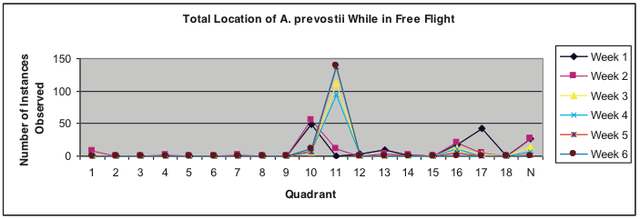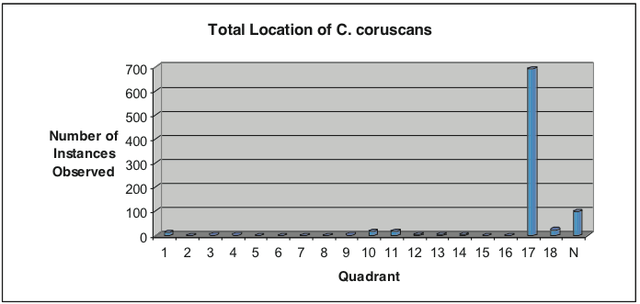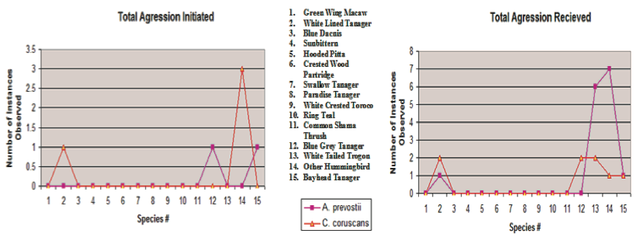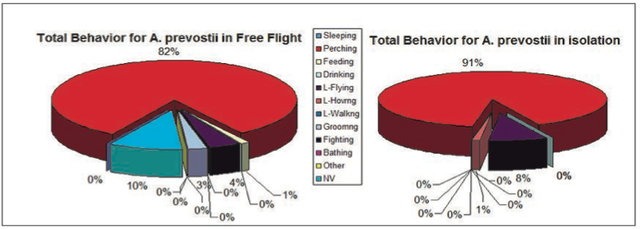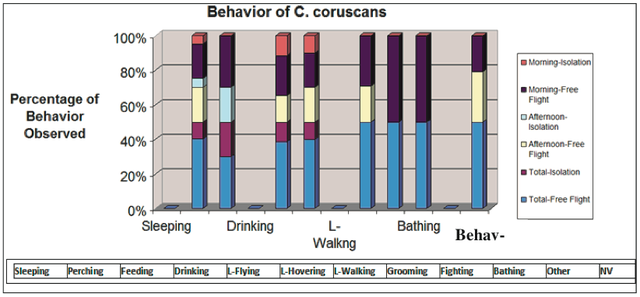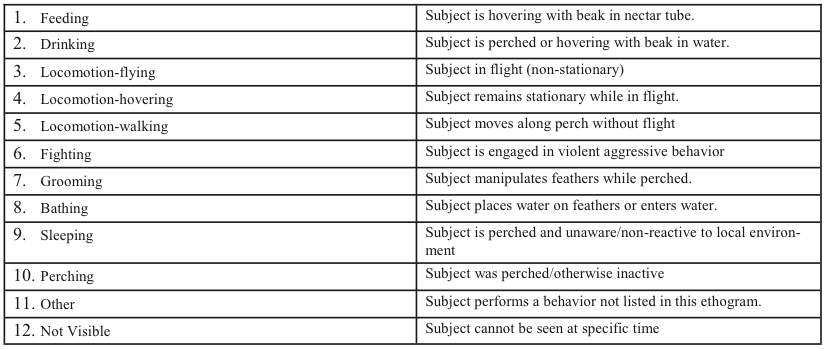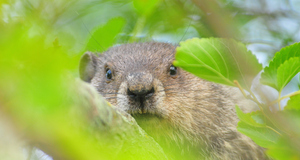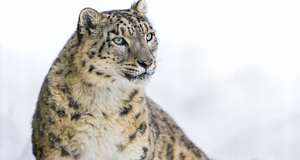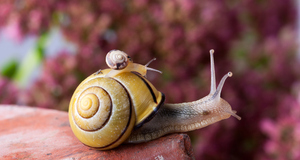From Discussions VOL. 5 NO. 1Adaptations and Preferences of Wild Hummingbirds Introduced into a Captive SettingMATERIALS AND METHODSThe subjects of this study were the Colibri coruscans (Sparkling violet eared) and Anthracothorax prevostii (Green Breasted Mango) hummingbirds. Both birds were on display at the Brookfield Zoo. The specific age of both hummingbirds was unknown since they were originally from the wild. At the start of the observations, both birds were housed in an off exhibit holding area; this lasted for about 2 weeks and they were later moved into the Free Flight Aviary in the Perching Bird House. Data for both subjects was collected via the instantaneous sample collection method. Each subject was individually observed for 15 minutes in the morning (approximately 10am) and again individually observed for 15 minutes in the afternoon (approximately 2pm) for approximately 8 weeks. Times of observation varied slightly as the upkeep of the exhibit delayed the start of the observations. To avoid observing the animals after being disturbed, an additional 5 minutes were allotted, and the new observation start time was noted. The subjects were observed for the following criteria every minute: location, social proximity, and behavior during the 15 minute observation period. The location of the subjects was recorded by mapping the exhibit into approximately equal sized quadrants. These quadrants was later be used to help record the location of each subject at each 1 minute instantaneous sampling interval. The exhibit was divided into 18 quadrants measuring 2 quadrants deep, 3 quadrants in length, and 3 quadrants high. Each quadrant was approximately 125 cubic feet (5x5x5). However, the size of the quadrants varied slightly to fit in with the exhibit. The numbering of the quadrants started at the top, front, left quadrant and then proceeded down the column. The numbering then continued from the top of the column on the immediate right. After quadrant 9, located on the bottom, front, right quadrant, the number proceeded to quadrant 10, in the top, back, left corner, directly behind quadrant one. The numbering process continued as in the front section (quadrants 1-9). Next, the social proximity of the two subjects was categorized according to the subject's nearness to other birds and recorded. The purpose this observation was to record the social interactions of the subject in relation to both the other birds in the enclosure as well as the other hummingbird subject. The proximity of the subject to other birds was based on a 2 foot radius around the subject and further defined based on the following:
proximity to one another and the other birds in the exhibit, a count of aggression, which received or expressed the aggression, was recorded. This tally of aggression was gender neutral, as it was impossible to identify the gender of every bird without close examination of the bird's band. As a result, the bird's particular species was used as classification instead. The behavior of the subjects was also recorded. These behaviors were based on an ethogram (see addendum 1) of both known and observed behaviors. The ethogram was designed based on the priorities of behaviors, to eliminate the possibility of having 2 behaviors for one particular sample. RESULTSThe total data for the location for A. prevostii shows little difference between morning and afternoon observations while in Free Flight. The location in isolation was not recorded since the size of the holding cage was smaller than one quadrant. However, there is a difference in the subject's location over the six week span of time in the Free Flight exhibit. Figure 2 shows a shift in the preference of location towards the beginning of week 3 from quadrant 10 to quadrant 11. The overall location for C. coruscans showed a consistent prefer-ence for quadrant 17 during both the morning and afternoon observations, as is seen in Figure 3. Figure 2. Total Location of A. prevostii While in Free Flight Figure 2 is the data of both morning and afternoon observations on location for A. prevostii while in Free Flight. Figure 2 shows a clear transition in preference in location for quadrant 10 in weeks 1 and 2, to a preference of quadrant 11 in weeks 3, 4, 5, and 6.
Figure 3. Total Location of C. coruscans Figure 3 shows the location of C. coruscans while observed in Free Flight. Figure 3 shows the preference of C. coruscans of quadrant 17.
The social proximity of both subjects was consistent. It comprised entirely of point 2 on the social proximity chart: ―bird is alone, but is engaged in watching other birds.‖ Though usually isolated from other birds, both subjects received and initiated aggression with the other birds as seen in Figure 4 (next page). Figure 4 shows the number of instances of aggression received and initiated. C. coruscans was observed initiating more acts of aggression, especially against A. prevostii. C. coruscans also received less aggression than A. prevostii. The behavior of A. prevostii showed no difference between the morning and afternoon observations. There was a difference, however, between the behaviors noted while the subject was in isolation holding and, afterwards, in the Free Flight Aviary. As can be seen in Figure 5 (next page), there is a significant drop in the amount of perching behavior when in Free Flight as well as a slight decrease in the flying behavior compared to its behavior observed in isolation. Figure 4. Total Aggression Initiated and Received by A. prevostii and C. coruscans Figure 4 shows the number of observed instances of received and initiated aggression. It can be seen in the left portion of that C. initiated more instances of aggression, especially towards A. prevostii, that A. prevostii. The right portion shows that A. prevostii received more instances of aggression from other birds than C. coruscans.
Figure 5. The Total Behavior of A. prevostii in both Free Flight and Isolation Figure 5 shows the difference in total behavior fro A. prevostii between the two environments: Free Flight, isolation. There is approximately a 10% decrease in the number of perching observations, as well as a 50% decrease in the number of flying observations.
Figure 6. Behavior of C. coruscans Figure is a stacked graph that shows the percentage of a behavior at a particular time. Figure 6 shows that certain behaviors are prevalent regardless of location or time, such as perching and flying. Other behaviors such as bathing, fighting, feeding, and grooming are only seen at certain times and only in Free Flight.
The behavior of C. coruscans was consistent. However, as can be see in Figure 6 (next page), certain behaviors were more prevalent depending on the time or location. Figure 6 shows that both fighting and bathing behaviors were only witnessed in Free Flight and in the morning. It also shows that behaviors such as feeding, grooming, fighting, and bathing were not seen, either in the morning or afternoon, while C. coruscans was in isolation.Continued on Next Page » Suggested Reading from Inquiries Journal
Inquiries Journal provides undergraduate and graduate students around the world a platform for the wide dissemination of academic work over a range of core disciplines. Representing the work of students from hundreds of institutions around the globe, Inquiries Journal's large database of academic articles is completely free. Learn more | Blog | Submit Latest in Biology |

